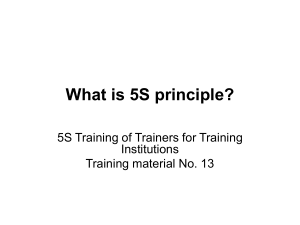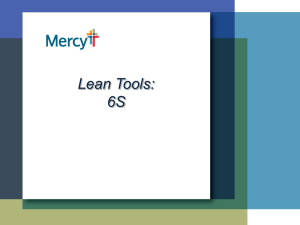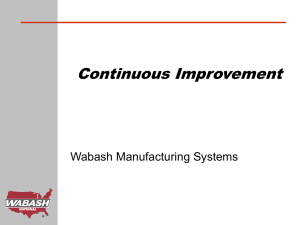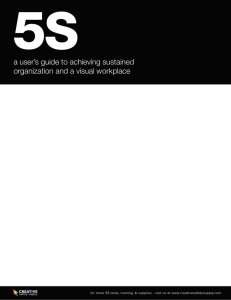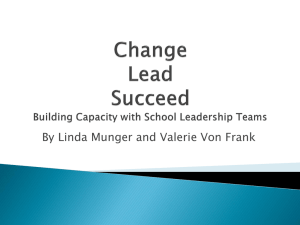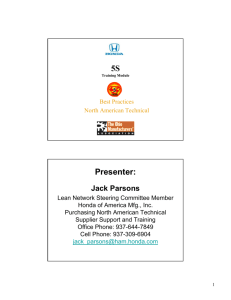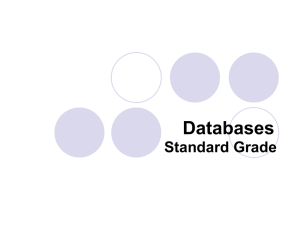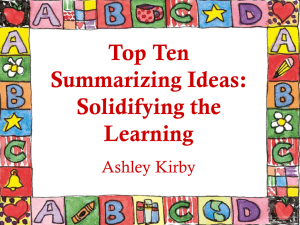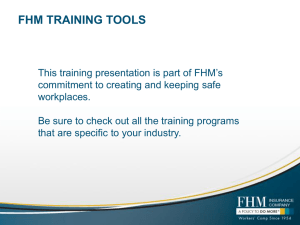5S-Training-Office
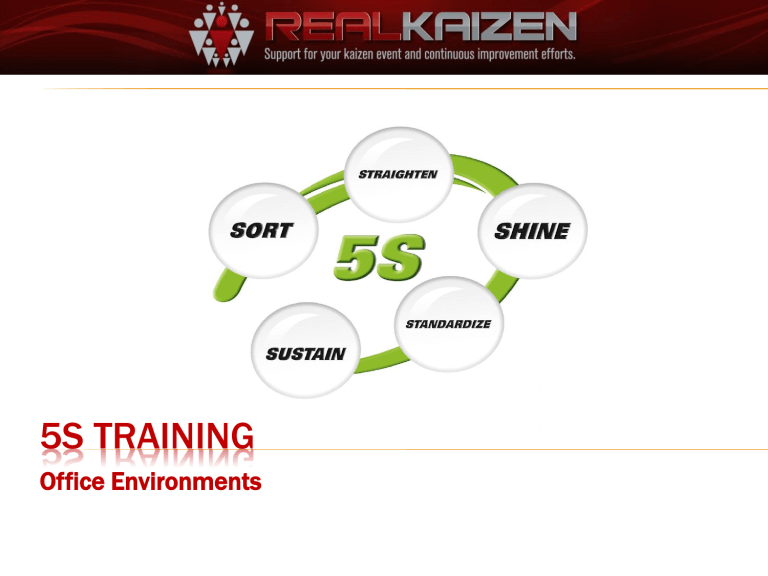
5S TRAINING
Office Environments
WHAT IS 5S?
5S is a process for implementing and maintaining a clean, safe, and organized work area.
5S provides a way for organizations to operate efficiently and effectively.
5S is a Lean Organization tool that helps build a foundation for continuous improvement.
http://REALKaizen.com
WHAT ARE THE 5S’S?
Japanese 5S’s English Translation American 5S Standard
S eiri Put Things in Order S ort
S
S
S
S eiton eiso eiketsu hitsuke http://REALKaizen.com
Proper Arrangement S traighten
Set in Order, Simplify
Clean
Purity
S hine
Scrub, Sweep
S tandardize
Commitment S ustain
Discipline
DEFINITION OF THE 5S’S
Sort - Define what is and isn’t needed in the area to do the job. Remove items not needed: tools, books, instructions – prioritize essential items
Set in Order - Organize the work area based on ‘A place for everything and everything in its place.’ Designate locations for files, tools, equipment, supplies, etc. and label properly
Shine - Clean, sweep, scrub, etc.
Standardize - Identify “Best Practices” and document them so they can be followed by everyone. Use same tools, processes, and documentation where applicable.
Sustain – Maintain and review with everyone involved.
Continual reinforcement of the importance of 5S; Audits,
Culture change – make it a habit.
http://REALKaizen.com
WHY 5S?
A cleaner & more organized work area results in higher employee morale.
Improved output and quality from knowing exactly where to find files, drawings, manuals, supplies, etc.
Reduced cost from not having to re-purchase lost or damaged items.
Streamlined processes through elimination of waste.
More organized and efficient workplace can lead to potential increase in orders, growing profitability
The Visual Workplace affects everyone!
http://REALKaizen.com
SORT
Remove non-essential items from work area
Sort through desk drawers, file cabinets, carts, tables, office supplies, materials, paper work, and discard unneeded items
Remove hardcopy items where not needed
Sort computer files the same as hardcopy files – remove outdated and unused folders http://REALKaizen.com
SET IN ORDER
Replace files and folders in a more organized manner
Organize by removing waste in the processes; reduce movement and transportation
Label files, drawers, cabinets, shelves, etc. Label office equipment in common areas.
When labeling, ask the question “Could someone find these items if I’m not here?” If not, label it.
Use color coding to make it easier to locate and store similar information.
http://REALKaizen.com
SHINE
Clean, dust, and mop to show off your work area
Dirt, dust and clutter can have an adverse effect on quality, safety, and morale - clean everything.
Clean work environments leave customers with a comfortable feeling about your quality.
Any necessary repairs should be noted and fixed on the spot http://REALKaizen.com
STANDARDIZE & SUSTAIN
Standardize
Define and document best practices for accomplishing the tasks in the area. Eliminate waste in tasks and processes.
Train everyone to the best practices
Sustain
Make 5S a daily part of standard work
Define tasks needed to maintain 5S. Implement daily and weekly assignment sheets to insure tasks are completed.
Set up auditing to ensure ongoing use http://REALKaizen.com
5S IN THE OFFICE
Personal Items – Good Practice!
We spend 8+ hours at work - pictures and personal items can inspire, motivate and let others know a little about us and make others feel a little more comfortable
Bulletin Boards – Should be informative and fun!
Should contain updated and needed information and are located in an area that is easily accessible by all.
Bulletin boards can be a great way to tell others about the people who work in the department, what the department has accomplished, or for recognizing exceptional performance.
Give them a personal touch!
http://REALKaizen.com
5S CREATES THE ENVIRONMENT FOR IMPROVEMENT
Work Smarter not Harder
Question all common practices – What value do they add?
How much waste is generated?
Is the office layout in the correct arrangement for accomplishing the work? Can/should desks and cabinets be moved?
Map processes or flow of information to identify waste
Waste exists everywhere and in many forms…..
http://REALKaizen.com
8 WASTES
http://REALKaizen.com
WASTE 1 - TRANSPORTATION
Definition
Unnecessary movement of items between processes
Causes
Poor layout and/or process Design & Planning
Unstructured or not understood Value Stream
Complex Material flow
Problems
Increased Time & Cost to transport & search
Increased Defects due to accidents http://REALKaizen.com
WASTE 2 - INVENTORY
Definition
Any raw material, Work in Progress (WIP) or finished goods which are being stored
Causes
Overproduction causes inventory build up between processes
Problems
Adds cost
Requires space
Hides process defects
Can become a defect http://REALKaizen.com
WASTE 3 - MOTION
Definition
Unnecessary movement within a Process
Causes
Poor workplace layout
Poor process planning
Poor Housekeeping
No Standard Operating Procedures
Problems
Adds time & cost
Can be a safety issue http://REALKaizen.com
WASTE 4 - WAITING
Definition
People or Parts that are waiting for a work cycle to be completed
Causes
Unreliable Supply Chain
Bottlenecks
Down Time
Problems
Excessive Lead Time
Causes Bottle Necks
Additional Time & Cost http://REALKaizen.com
WASTE 5 – OVER PROCESSING
Definition
Processing beyond the value required by the Customer
Causes
Lack of Customer Focus
“Always done it this way”
Lack of understanding
Scheduled work time is longer than needed
Problems
Increases Time & Cost http://REALKaizen.com
WASTE 6 – OVER PRODUCTION
Definition
To produce items sooner or in greater quantities than required for customer demand
Causes
Poor planning
Incorrect bottleneck assumptions
Problems
Overproduction discourages a smooth flow of production
Leads to excessive work in process inventory http://REALKaizen.com
WASTE 7 – UNDERUTILIZED PEOPLE
Definition
Underutilization of people’s Abilities, Knowledge, and
Skills
Causes
Constant management turnover unaware of talent pool
Employee not happy in current position
Problems
Great ideas might be missed
Dominant personalities may force focus in wrong direction http://REALKaizen.com
WASTE 8 - DEFECTS
Definition
A defect is when the Customer believes they did not get what they paid for
Causes
Process Variation
Customer requirements not understood
Problems
Additional Time & Cost
Reduces Customer Confidence http://REALKaizen.com
BEFORE & AFTER 5S
http://REALKaizen.com
